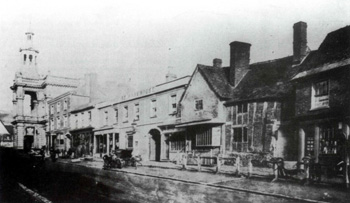The Nags Head Lake Street Leighton Buzzard

Aveline and Philips at the end of the 19th century (with the cart outside)
The Nags Head Public House: 17 Lake Street, Leighton Buzzard
The Manor of Leighton Buzzard alias Grovebury was the principal landowner in the town before the 19th century. Bedfordshire & Luton Archives & Records Service has a full run of court rolls from 1393 to 1727 [KK619-715] and another full run from 1704 to 1867 [X288/1-23]. The service also has court rolls for other manor to own land in the town, the Prebendal Manor, from 1448 to 1459, 1588 to 1591, 1611 to 1622, 1627 and 1631 [KK792-1798]. Detailed study of these would be bound to produce quite full histories for most licensed premises in the town. Unfortunately such study would take a very long time. Thus the histories of licensed premises in these web pages are quite summary and not necessarily the full story.
Maureen Brown and June Masters wrote a book called the Inns and Taverns of Lake Street published by Leighton Linslade Museum Project in 1988. The first reference they found to the Nags Head was in 1699 when Michael Higbid and his wife Mary were admitted to the copyhold inn at the manorial court on surrender of Sarah Poole, widow [X288/27] which describes the property as "two messuages in Leckend le Naggshead". In 1726 when Michael Higbid devised it in his will to his son William; the will was proved the following year [RY315]. William died in 1741 and the manorial court roll for Leighton Buzzard alias Grovebury states that by this date the inn was divided into two tenements in occupation of Stephen Search and William Wingrave [X288/5]. William devised the Nags Head to his brother Thomas.
Maureen Brown and June Masters discovered a Royal Exchange Fire Insurance document for the inn of 1783 when Robert Turnham was owner and licensee, though no reference is given for this document. The inn was described thus: "House in two tenements lath and plaister built and tiled, situate in the Corn Market of Leighton Buzzard in occupation of himself and William Hall, a victualler, and known by the sign of the Nag's Head. Storehouse and maltkiln adjoining near, three stables and a crossbarn adjoining and belonging, a tenement and a gatehouse adjoining, plaister built and tiled, situated next to the street".
In the Northampton Mercury of 19th January 1793 licensee of the Nags Head, W. Yerrell, subscribed to a resolution of Leighton Buzzard publicans banning "seditious and disaffected persons" from their houses. This presumably was in reaction to the events across the Channel in France (four days previously King Louis XVI had been sentenced to death and two days later he went to the guillotine).
In 1861 the public house closed because the owners wanted it for their own purposes. The tenant, Charles Reeve, found a property in Mill Road and transferred the licence to that [PSLB1/1], also naming it the Nags Head.
Maureen Brown, June Masters and Tom Lawson wrote a book called The Old Pubs of Leighton Buzzard and Linslade which was published by Leighton Linslade Local History Research Group in 1994. In producing the book they used sources at Bedfordshire & Luton Archives & Records Service, Buckinghamshire Record Office, Northamptonshire Record Office as well as a number of published sources. The authors reveal that the Nags Head in Lake Street became upholsterers and cabinet makers Aveline and Phillips who also undertook removals, the building receiving a more modern front at that time.
This building was demolished by 1981 and today's 17 Lake Street, at the time of writing [2009] chemists Cox and Robinson, stands on the site.

Cox and Robinson June 2008
References:
- RY315: devise of the Nags Head: 1726, proved 1727;
- X288/5: death of William Higbid: 1741;
- Northampton Mercury: resolution of Leighton Buzzard publicans banning "seditious and disaffected persons" from their houses: 19 Jan 1793;
- CLP13: Register of alehouse licences: 1822-1828;
- PSLB1/1: transfer of licence to Mill Road: 1861
List of Licensees: note that this is not a complete list; entries in italics refer to licensees where either beginning or end, or both, dates are not known:
1726: Michael Higbid and Stephen Search;
1741: Stephen Search and William Wingrave;
1783: Robert Turnham and William Hall;
1793: W. Yerrell;
1822-1839: Thomas Yerril or Yerrell;
1847: Catherine Yirrell;
1850: James Snoxell;
1853-1854: Clark Loke;
1857-1861: Charles Reeve